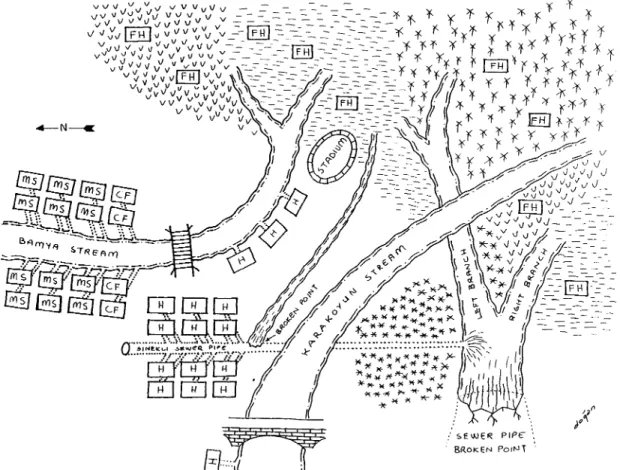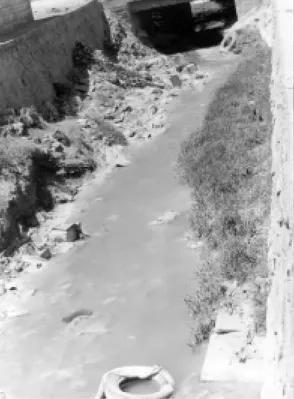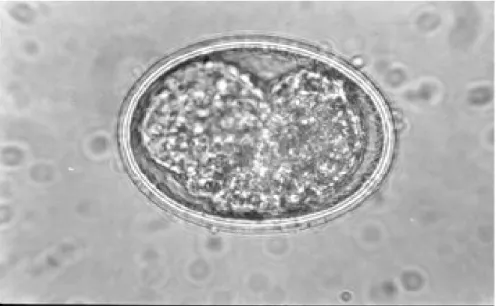Environmental Pollution with Soil-transmitted Helminths
in Sanliurfa, Turkey
Mustafa Ulukanligil
+, Adnan Seyrek, Gonul Aslan, Hatice Ozbilge,
Suleyman Atay
Mikrobiyoloji Anabilim dali, Harran Universitesi Tip Fakültesi Arastirma Hastanesi, Sanliurfa, Turkey
Soil transmitted helminth (STH) infection are endemic in developing countries. A study was carried out of sewage farms, streams and vegetables to determine the sources and routes of STH infection in Sanliurfa, Turkey. Stool samples from farmhouse inhabitants as well as soil and vegetable samples from the gardens were collected and examined. In addition, water samples from streams and vegetable samples from the city market were collected and examined. One hundred and eighty-seven (59.5%) of a total of 314 samples, including 88.4% of the stool samples, 60.8% of the water samples, 84.4% of the soil samples and 14% of the vegetable samples, were found to be positive for STH eggs.
These results indicate that the water, soil and vegetables are heavily contaminated, and suggest a vicious circle between humans and the environment. Improving environmental sanitation is imperative for the control of soil-transmitted helminthiasis in Sanliurfa.
Key words: environmental pollution - soil-transmitted helminthiasis - Sanliurfa - Turkey
Soil-transmitted helminth (STH) infections are endemic in communities where poor environmental sanitation and poor personal hygiene are preva-lent, as occurs in the majority of developing coun-tries (Yodmani et al. 1982). Yu et al. (1993) showed that environmental pollution, sanitary condition and human behaviour play an important role in the trans-mission of STH infection. Yodmani et al. (1982) in-dicated that many sources of ascariasis from the host and in the environment such as soil in the shantytowns and vegetables sold in the market re-sulted in continuous active transmission of ascari-asis in the area.
Sanliurfa, a city in southern Turkey, has a mod-ern centre, but is surrounded by shantytowns. Per-sonal hygiene habits are poor, and standard clean-liness, the washing of hands and food, and the cleaning the streets are largely ignored. Garbage is allowed to accumulate at unsanitary refuse stations in the city centre and is not regularly disposed of outside of the city. The machine shops, cement fac-tories and houses dispose of their refuse and sew-age in the streams at the city centre. Many sewer pipes have been broken and night soil flows to-wards the vegetable gardens to cultivate them.
+Corresponding author. Fax: +90-414-3151181. E-mail:
mulukan@bigfoot.com Received 26 December 2000 Accepted 22 June 2001
Soil pollution with faecal materials is instrumen-tal in the transmission of STH infection. Fertilised eggs deposited in the soil develop rapidly and, de-pending on environmental conditions, may reach the infective stage within a matter of weeks (Klaas 1987). Thereafter, eggs are transferred from soil to the vegetables then onto to hands and finally to the mouth (Kobayashi 1999).
Ozbilge et al. (1998) and Nazligul et al. (1997) have reported the prevalence of intestinal parasites in the population to be near 60% in Sanliurfa, the predominant cause of infestations being Ascaris lumbricoides. These studies attributed the high incidence of intestinal parasites to the use of night soil in vegetable gardens. Unfortunately, no data is available on the contamination of soil, water and vegetables in this region.
In the present study, environmental pollution with nematode eggs was investigated in order to determine the sources and routes of infection and to devise effective control strategy.
MATERIALS AND METHODS
In Sanliurfa, the climate is hot and dry. The av-erage temperature is 5-10°C in winter and 40-50°C in summer. The average humidity is 70% in winter and 28% in summer. Annual rainfall is 463 mm, sum-mer and winter rainfall being 70 mm and 0.6 mm respectively. The population of the city is 500,000.
Karakoyun stream begins in the northwest of the city, near the village of Karakopru. Its bed and banks are cemented and it is nearly dried up. Refuse and sewage from homes are disposed in it as it flows towards the city centre. Karakoyun stream runs past a refuse transfer station where municipal refuse accumulates in the daytime and waste is dis-charged into the stream (Fig. 4). Later, it is drained near the vegetable gardens by a motor-driven pump. Just behind this refuse transfer station, the city’s main underground sewage pipe has been broken by farmers, producing a stream. with a volume
ach and parsley gardens at every farm. Three soil samples were taken from the children’s playing area in the yard at every farmhouse. Ten soil samples were also taken from the banks of streams and canali-culi into gardens; (2) water samples from Bamya stream were taken from machine shops, cement fac-tories, the shantytown of Sinekli and near gardens. Water samples from Karakoyun stream were taken near the refuse transfer station. Sewage water samples were taken near broken sewer pipes and in gardens; (3) ten kinds of vegetables (lettuce, spinach, pars-ley, onion, garlic, peppermint, cabbage, black
bage, mustard and purslane) are sold in the city mar-ket and three samples of each kind of vegetable were used in the study.
A total of 314 samples were collected. All water samples were placed in 10 ml screw-lid centrifuge tubes and labelled. Soil samples were taken 2-5 cm
Fig. 2: a view of Bamya stream flowing near machine shops and cement factories.
Fig. 3: a view of Bamya stream flowing along the border of Sinekli shantytown polluted with wasters and garbages.
Fig. 4: a view of refuse tranfer station
beneath the surface of the soil, placed in polyeth-ylene bags and labelled. Vegetable samples were placed in polyethylene bags and labelled.
found together in most of the soil samples in aver-age of 3.3 eggs per positive sample (Figs 5, 6).
The results of the detection of STH eggs in 46 water samples taken from different sites of streams and sewage water were shown in Table IV. Ascaris
eggs were detected in the 60.8% of the water samples and were found in 31.2% of Bamya stream, 75% of Karakoyun stream and 76.9% of sewage stream samples. The total number of Ascaris eggs was higher in sewage water than Karakoyun and Bamya stream water. Moreover, no eggs were de-tected in the samples taken at the points where Bamya stream passes near the cement factories. Other detected parasites were T. trichiura from one sample (2.1%), H. nana from one sample (2.1%) and
T. saginata from one sample (2.1%).
Fourteen vegetables were found to be contami-nated with STH eggs. Fertile Ascaris eggs were detected in one lettuce sample and two parsley samples from gardens and in four peppermint samples, and in one sample each of lettuce, onion, mustard and parsley from the market. T. saginata
eggs were detected in one parsley sample from a single garden and H. nana eggs were found in one lettuce and one peppermint sample from the market (Table V).
DISCUSSION
This preliminary study indicated that heavy environmental pollution was a source of soil
trans-Samples No. of samples No. of positive (%)
Stool 78 69 (88.5)
Water 46 28 (60.8)
Soil 90 76 (84.4)
Vegetables 100 14 (14)
Total 314 187 (59.5)
TABLE III
Results of examination of the collected soil samples for Ascaris lumbricoides eggs
Places No. of No. of Monocell to Infected stage MEPGS
samples positive (%) morula No. (%) No. (%)
Garden soils 50 46 (92) 34 (73.9) 32 (69.5) 3.4
Bank soils 10 7 (70) 7 (100) - 3.5
Yard soils 30 23 (76.6) 17 (73.9) 13 (56.5) 3.2
Total 90 76 (84.4) 58 (76.3) 45 (59.2) 3.3
MEPGS: mean eggs per gram soil
The results of the stool examination are pre-sented in Table II; 88.5% of the samples were found to be infected by soil transmitted helminthiases. Double infections were most prevalent withonly
A. lumbricoides and Trichuris trichiura double in-fections were detected. In single inin-fections,A. lumbricoides was common and closely followed by T. trichiura. MEPG (mean eggs per gram stool) represents intestinal worm burden in the host and both Ascaris and Trichirus infections showed mod-erate intensities with their MEPG being under 10,000 and 3,000 respectively. The highest worm burden was seen in mixed infections in which their MEPG was 17,000. Eggs of other species were not de-tected.
The results of the detection of Ascaris eggs in soil samples and the rates of different stages of
mitted helminthiases that were transmitted by veg-etables and soil contaminated with night soil in Sanliurfa. The environmental pollution is the result of poor environmental sanitation and poor hygiene habits, reflecting the population’s behaviour regard-ing environmental sanitation, and the public health authorities’ negligence of this issue. The popula-tion is unaware both in terms of sanitapopula-tion and hy-giene habits and in terms of knowledge of public health and how to avoid environmental pollution.
The health authorities do not see this problem as a public health threading issue.
Examination of stools revealed that STH infec-tion in farmers was very prevalent (88.7%) than the population (60%) in Sanliurfa. On farms, adults and children were equally susceptible to STH infections. Adults work in the soil with their hands and mode of infection is by ingestion of embryonated infec-tive eggs, which have developed in soil, and reach the mouth by soiled hands. In addition, they were
Fig. 5: embriyonated Ascaris lumbricoides egg detected in a soil sample.
ingested to eggs by eating the raw vegetables with-out cleaning. The children contaminate the yard with their excreta and thus seede the soil with As-caris eggs, which after development and matura-tion provide a source of reinfecmatura-tion.
This study showed that viable-stage ova were present in the irrigation water (60.8%) and cause soil contamination. Refuse and wastes were dis-posed in the streams without any precautions. Nearly all of the sewer pipes in the city was broken and the night soil passed into small canaliculi in the gardens and even in the yards. Night soil has been used on cultivated fields as fertiliser, and con-sequently eggs are dispersed in the soil of yards and gardens, and occasionally onto vegetables. This study also revealed that although, Bamya
tions in farmers families, we could not find its eggs in the soil. This may be explained by the fact that eggs of T. trichiura are less resistant to environ-mental stress such as drying or direct exposure to sunlight (Klaas 1987).
Examination of vegetables revealed that the onion, garlic, lettuce, spinach, peppermint and pars-ley carried A. lumbricoides,T. saginata and H. nana
eggs. These vegetables are grown in Sanliurfa and usually eaten raw. These highly contaminated veg-etables were a source of STH for the population in Sanliurfa. Cabbage, black cabbage and purslane, which are exported to other parts of Turkey, were not found to be contaminated.
Many studies were reported environmental pollution with soil transmitted helminths. Toan (1994) made a study in similar environmental con-ditions in a rural area in Vietnam and found that the prevalence of soil transmitted helminth infection was high and all of the soil samples were positive for Ascaris eggs. Muttalib et al. (1983) reported that 80-90% of human excreta found its way into soil or water, and refuse, garden, and water sources were found to be infected in Bangladesh, predominantly by Ascaris ova. Fueki (1952) established that night soil is widely used as fertiliser in rural areas in Ja-pan, and that nearly half of the vegetables sold in markets are contaminated with Ascaris eggs.
The city’s municipal, health and other govern-mental sectors have responsibility for this serious environmental pollution. The authorities of these sectors neglect these seriously public health
thread-near refuse
transfer station 4 3 (75%) 21
Main sewer water
broken point 6 6 (100%) 92
left branch 2 1 (50%) 21
near gardens 7 6 (85.7%) 64
inside gardens 6 3 (50%) 32
Lateral sewer water
broken point 2 2 (100%) 61
Sewer water
Sinekli shantytown 3 2 (66.6%) 23
Total 46 28 (60.8%) 321
TABLE V
Detected soil transmitted helminths in vegetables
No. of No. of AL (%) TS (%) HN (%)
samples positive (%)
Gardens 50 4 (8) 3 (6) 1 (2)
-Market 50 10 (20) 8 (16) - 2 (4)
Total 100 14 (14) 11(11) 1 (1) 2 (2)
ing conditions and take no preventive measure-ments against usage of night soil in vegetable gar-dens. However, academic sectors may play a role to aware of governmental and non-governmental organizations about environmental pollution. A joint project should be implemented with the coop-eration of municipal, health, governmental, and pri-vate sector. These projects should contribute to a wide-ranging examination of the problem, and pre-ventative education for the population. Public health conditions should have top priority in solv-ing this serious health problem. First priority is that prohibition of the use of night soil as a fertiliser for cultivation of vegetables. In addition, media (radio, television, newspaper etc.) programmes may be ef-fective to awareness of community about environ-mental sanitation and hygienic habit.
ACKNOWLEDGMENTS
To Dr Semra Ozcelik of the Sivas Medical Faculty, Dr Noboru Kagei and Dr Takaaki Hara from Japan As-sociation of Parasite Control for help to distinguishing free-living larvae from infective larvae. To Dr Dogan Unal for drawing the study map.
REFERENCES
Fueki K 1952. On the modes of Ascaris infection. Keio J Med 1: 21-34.
Kagei N 1983. Techniques for the measurement of envi-ronmental pollution by infective stage of soil trans-mitted helminths. In M Yokogawa, Collected Paper on the Control of Soil Transmitted Helminthiases, Vol. II, APCO, Tokyo, p. 27-46.
Klaas J 1987. Lumen dwelling helminths. In JB Howard, Clinical and Pathogenic Microbiology, The CV Mosby Company, Missouri, p. 658-687.
Koyabashi A 1999. Ascaris. In JICA, Textbook for Semi-nar on Parasite Control Administration for Senior
Officers - A Step Towards Primary Health Care, Chap-ter 5, Tokyo, p. 233-242.
Muttalib MA, Huq M, Huq JA, Suzuki N 1983. Soil pollution with Ascaris ova in three villages of Bangladesh.In M Yokogawa, Collected Paper on the Control of Soil Transmitted Helminthiases, Vol. II, APCO, Tokyo, p. 66-71.
Nazligul Y, Dalmaz M, Ozbilge H, Sabuncu T, Cebeci B 1997. Sanliurfa ilinde barsak parazitlerin kendi icinde ve mevsimsel dagýlýmý (Turkish). XV Gevher Nesibe Medical Days, Kayseri, Turkey.
Ozbilge H, Seyrek A, Aslan S, Tasci S 1998. Distribu-tion of intestinal parasites in Sanliurfa (Turkish). Turkish Parasitol Bull1: 41-43.
Suzuki N 1980. Diagnostic methods in intestinal helm-inth infections. In M Yokogawa, Collected Paper on the Control of Soil Transmitted Helminthiases, Vol. I, APCO, Tokyo, p. 25-33.
Suzuki N 1981. Colour Atlas for Human Helminth Eggs, JAPS&JOICFP, Hoken Kaikan Group, Tokyo, p. 44-56.
Toan DN 1998. Contamination of soil with Ascaris and Trichuris eggs in a rural area of Vietnam. In M Yokogawa, Collected Paper on the Control of Soil Transmitted Helminthiases, Vol. VI, APCO, Tokyo, p. 87-91.
Yodmani B, Sornmani S, Platihotakorn W, Harinasuta C 1982. Reinfection of ascariasis after treatment with pyrantel pamoate and the factors relating to it’s ac-tive transmission in a slum in Bangkok. In M Yokogawa, Collected Paper on the Control of Soil Transmitted Helminthiases, Vol. II, APCO, Tokyo, p. 89-100.


